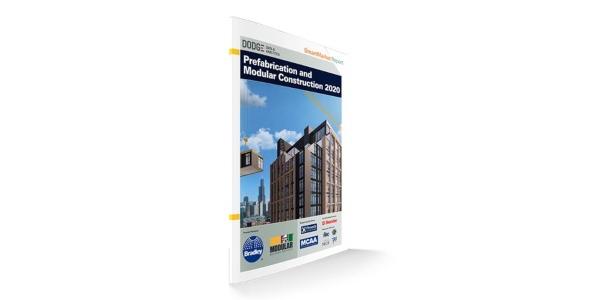UP TO THE MINUTE
Study: Prefabrication to Transform Construction Industry

By Karen L. Edwards, RCS Editor.
Dodge Data & Analytics released a SmartMarket report to examine the frequency of prefabricated products, the benefits as well as what drives their use and what gets in the way.
The Dodge study examined both prefabrication and modular building as two separate topics finding that they are at very different stages in their use, reporting that 94 percent of survey responders cited having experience with prefabrication over the last three years whereas only 38 percent reported using permanent modular construction.
We know that prefabrication is not new to the roofing industry. Manufacturers like Duro-Last have been offering prefabricated single-ply roofing membranes for years and contractors can use flashings and other accessories on commercial roof installations that are made ahead of time for faster installation.
The bottom line of the study showed that improvements in productivity, quality, safety, client satisfaction, scheduling and reduction in waste all resulted from the use of prefabricated materials. Let’s take a look at some of the numbers.
General contractors and construction managers reported a 90 percent improvement in productivity, quality and increased schedule certainty when using prefabricated materials. 85 percent reported reduction in waste generated by construction and 83 percent said they saw improved safety performance and cost predictability. Increased client satisfaction was an added result with 79 percent seeing improvements.
The numbers were even higher from trade/specialty contractors. 93 percent saw improved quality followed closely by improved productivity at 92 percent. Increased schedule certainty, improved safety and cost predictability ranked in the mid to high 80th percentiles.
The same trade contractors ranked the top factors that influence their decision to use prefabrication over the last three years. 66 percent cited improved productivity as their main influence, while remaining competitive came in close behind at 57 percent. Improved cost performance was third at 45 percent and workforce shortages followed at 43 percent.
Some of the top obstacles to not using prefabrication include the prefabrication not being part of the project design (54%), project delivery methods preventing effective prefabrication planning (33%) and availability of prefabrication shop locally (26%).
This latest study is a follow up to the 2011 study that Dodge first completed on prefabrication and modular building. In that study, participants also cited similar benefits with improved productivity and quality being the top benefits. With these kinds of results from the use of prefabrication, it’s pretty clear that it will become even more popular moving forward.
Download the full 68-page report here. To get more news and information like this in your inbox, sign up for the RCS Week-in-Review e-news.




















Comments
Leave a Reply
Have an account? Login to leave a comment!
Sign In